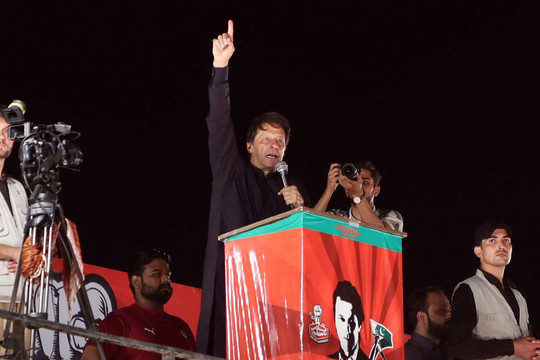Reporter Zamzam Saeed and her team were beaten in Karachi while covering a political rally of former prime minister Imran Khan’s Pakistan Tehreek-e-Insaf (PTI) party in Karachi. This was reminiscent of similar attacks on women reporters in 2014 by PTI party supporters.
Women journalists have been particularly targeted online, with many ceasing their use of social media platforms. However, this does not mean that men are safe, both genders are equally targeted – some notable examples include Hamid Mir, Talat Hussain, Asma Shirazi, Matiullah Jan and Ghareeda Farooqi.
Unfortunately, this is not the first time that the media has been targeted by the party. Since 2014, many journalists, including women, have been attacked while covering political rallies. This aggressive trend continued even after the PTI came into power in 2018.
In 2020, the number of attacks against the media was alarmingly high which led to a petition being filed in an attempt to combat increasing social media attacks on women journalists by ‘those affiliated with the government, political parties, their supporters and social media wings, impacting their work, mental wellbeing and security’.
However, the situation did not change after the PTI government was removed through a vote of no confidence in April 2022, as journalists deemed to be pro-Imran Khan are now being harassed, namely Arshad Sharif, Sabir Shakir, Imran Khan Riaz, and Moeed Pirzada.
There are even reports that journalist Arshad Sharif had been arrested by Pakistan’s Federal Investigation Agency (FIA), although the FIA has denied this in a tweet.
Pakistan has become a dangerous place for journalists, who are constantly under attack from different sections of society. The magnitude and impact of these attacks have amplified over the years, especially as the offline and online overlap.
According to the Freedom Network Pakistan Press Freedom Report 2022, between May 2021 to April 2022 at least 86 cases of attacks and violations against journalists and media practitioners were documented in Pakistan. This is an “average of over seven violations a month – one every fifth day”.
Things looked quite problematic when the PTI government proposed to form the Pakistan Media Development Authority (PMDA) in 2021 that would converge multiple media regulatory bodies and include digital media within its jurisdiction. Fortunately, the PMDA was disbanded by the incoming government, deemed it to be a"black" law that ‘restricted the people's constitutional right to freedom of expression’.
The government needs to work to strengthen the media in Pakistan and ensure that its constitutional rights are safeguarded so that it can continue to work with complete transparency. It should also engage with media unions and other media bodies to work towards a stronger media and protect freedom of expression.
A regulatory body can be established which includes members from an appropriate cross section of Pakistan’s media landscape, to ensure proper representation, guarantee that regulations allow the media to function as per the constitution, and prevent the prosecution of journalists for doing their jobs.
Lubna Jerar Naqvi is a freelance journalist and the Pakistan Gender Coordinator of the IFJ Asia Pacific.

